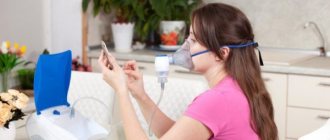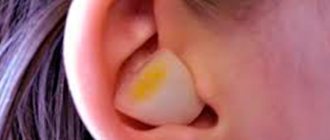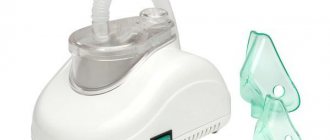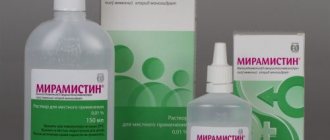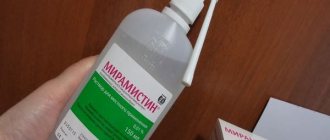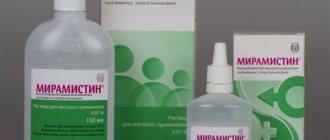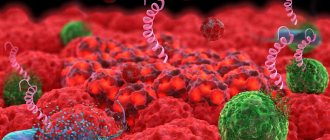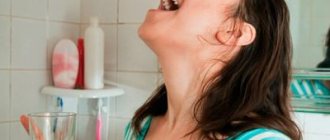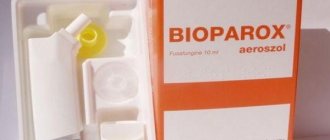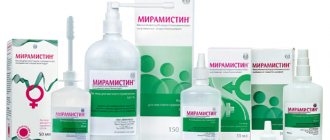Methods of using the drug for the treatment of sinusitis
With sinusitis (sinusitis of the paranasal sinus of the upper jaw), foci of bacterial, viral or fungal infection occur in the maxillary sinuses, contributing to the accumulation of pus and causing difficulty breathing.
To remove pus, destroy pathogenic microorganisms and normalize breathing, it is effective to use Miramistin solution.
For sinusitis, the simplest and most accessible method at home is as follows:
- Clear the nasal passages of mucus and secretions (for example, using Naphthyzin).
- Fill a teapot or syringe with Miramistin.
- Leaning over the sink and tilting your head to one side, the drug should be poured into the nostril that is located higher in relation to the second.
- After administration, you should wait until the liquid begins to flow freely from the other nasal passage.
- After this, the procedure is repeated for the opposite nostril.
A slight “burning” sensation in the nose is allowed. Before using this method for a child, you should dilute the solution with warm water in a ratio of 1 to 1. It is recommended to perform such procedures three times a day for a week. An improved version of this procedure, called “cuckoo,” is considered more effective for sinusitis.
For sinusitis, the Proetz rinsing method (“cuckoo”) is performed as follows:
- A movement of healing fluid is created from one nostril to the other.
- The patient continuously says “ku-ku”.
- Periodically, the doctor pinches the patient's nostril for a few seconds and then releases it (this helps the fluid to better fill the sinuses).
Irrigation technique
In the complex treatment of sinusitis, irrigation with Miramistin is used to destroy pathogens. Accumulations of pus from the maxillary sinuses are not removed.
Before irrigation, the nasal passages must be cleaned and then placed in a horizontal position. The head should be tilted back, then the drug should be injected into the nose using the nozzle that comes with the bottle.
First, the drug is sprayed inside one nostril, then inside the other. After irrigation is completed, you must lie still for three to five minutes.
Sanitation technique
Sanitation with Miramistin for sinusitis is usually carried out after surgical intervention in the area of the maxillary sinus of the paranasal sinus. When a sinus puncture is performed, the surgeon injects an antiseptic solution of Miramistin with a volume of about 10 ml into the maxillary sinus.
Sanitation for sinusitis helps to significantly speed up recovery: after 3-5 such procedures, the purulent process is stopped, breathing becomes easier, the temperature normalizes, and the patient’s general condition improves.
Inhalation technique
For inhalation of sinusitis, it is recommended to use a nebulizer. The dose of Miramistin solution for an adult is from 5 to 7 ml, three milliliters is enough for a child. Children under 12 years of age need to dilute the drug with a 0.9% aqueous solution of sodium chloride (saline) in a 1 to 1 ratio.
The inhalation procedure for sinusitis using a nebulizer is carried out as follows:
- clear the nasal passages;
- fill the device with the drug, turn it on;
- Apply an inhalation mask to your face and breathe quietly for 5-10 minutes.
Inhalation must be done through the nose, and exhalation through the mouth. After the procedure is completed, it is not recommended to consume drinks or food for the next 30 minutes. Inhalations for sinusitis using a nebulizer are carried out three times a day, for one to two weeks.
The active substance of Miramistin is benzyldimethyl. . To treat nasal diseases, you can purchase medicine for instillation into the nasal passages and for spraying into the nasal cavity.
The antiseptic solution has no specific odor and begins to foam when the bottle is gently shaken. Miramistin in the nasal passages for sinusitis is prescribed to eliminate purulent and inflammatory processes.
Miramistin for sinusitis helps quite effectively. This drug destroys the membrane septa of pathogenic microorganisms that cause inflammatory processes in the sinuses. Within just a few days of use, not only bacteria, but also antibiotic-resistant fungi and viruses are completely destroyed.
Washing the nasal passages with Miramistin for sinusitis helps to effectively cleanse them of purulent contents. This medication only works locally and is not absorbed into the blood, so it can be prescribed to children and expectant mothers.
An antiseptic solution is available in pharmacies without a doctor's prescription, but this does not mean that you can self-medicate. This medicine should be prescribed by a doctor after a thorough examination of the patient.
When is the use of Miramistin indicated?
For sinusitis, sexually transmitted diseases (treponema pallidum, chlamydia, gonococci, trichomonas) and other infectious diseases, Miramistin is used in the form of a solution or ointment. It has a maximum effect on groups of staphylococci and streptococci. Anaerobic and anaerobic species of bacteria that form spores and asporogenous are susceptible to exposure, including those resistant to antibiotics (this is especially true for hospital infections).
But Miramistin is not limited to the antibacterial effect: it has a destructive effect on many types of fungi, and even on some types of viruses.
Due to its versatility and wide spectrum of action, the product is used in many areas of medicine:
- surgery;
- dermatology;
- dentistry;
- urology;
- venereology;
- otorhinolaryngology;
- obstetrics and gynecology.
The most common diseases that are recommended to be treated with Miramistin are: sinusitis, laryngitis, tonsillitis, otitis (chronic and acute).
Miramistin for sinusitis can be used in three ways:
- instillation;
- washing;
- rehabilitation;
- inhalation.
Washing with Miramistin for sinusitis is allowed not only as one of the elements of complex therapy, but as the main method of treatment. One of the unique features of Miramistin that helps treat sinusitis is that it stimulates the human immune system and increases the ability of body cells to regenerate.
With general weakness and high temperature, complex treatment and complete diagnosis are necessary.
How to use Miramistin for sinusitis? There are several options for administering the drug into the nose - rinsing, irrigation, sanitation, inhalation.
Nasal rinsing
How to rinse your nose with Miramistin for sinusitis? At home, a syringe or a small teapot is used for this.
First you need to clear your nasal passages. If the congestion is severe, you can drop Naphthyzin into your nose and wait until the swelling disappears.
Miramistin is taken into a syringe or kettle, bent over the sink and, tilting your head to one side, pour the solution into the nostril located above. The liquid should flow freely through the second nasal passage. The procedure is then repeated for the opposite side.
There may be a slight burning sensation, which soon goes away. For children, the solution is pre-diluted with warm water 1:1.
The frequency of washing is 3 times a day. Treatment is continued for a week. In a hospital setting, the “Cuckoo” procedure is performed to increase efficiency.
Inhalations
For inhalation you will need a nebulizer. The amount of solution for an adult is 5-7 ml, for a child – 3 ml. For children under 12 years of age, the drug is diluted with saline in equal parts.
Instructions for using Miramistin for sinusitis in the form of inhalations:
- Clear your nasal passages.
- Pour the solution into the device and turn it on.
- Bring the mask to your face and breathe for 5-15 minutes (inhale through your nose, exhale through your mouth). Breathing should be calm.
Inhalations are carried out three times a day, the duration of treatment is from 7 to 15 days. After the procedure, you must refrain from eating and drinking for half an hour.
Irrigation
Irrigation allows you to disinfect the mucous membrane of the nasal passages. This procedure cannot get rid of pus accumulated in the maxillary sinuses, but as part of a comprehensive treatment it improves the patient’s condition.
For this purpose, Miramistin for sinusitis is injected into the nose using the nozzle included in the kit. Before irrigation, you should clear your nasal passages and take a horizontal position with your head thrown back.
The nozzle is inserted into each nostril one by one and the drug is sprayed. After irrigation, you need to lie down for another 3-5 minutes.
Sanitation
How to use Miramistin for sinusitis for sanitation is determined by the doctor, since this procedure follows surgery. Having punctured the maxillary sinus, he uses a special syringe to inject about 10 ml of antiseptic into it.
The use of Miramistin at this stage of treatment accelerates recovery. To eliminate the purulent process, 2-5 sanitation procedures are sufficient.
Treatment of sinusitis with Miramistin gives positive results and allows one to avoid puncture in the initial stages of the disease. But for a lasting recovery, supervision by the attending physician is necessary. Trying to get rid of sinusitis on your own can have fatal consequences.
Miramistin is a domestically produced medicine that is classified as an analogue of Chlorhexidine. It effectively copes with bacteria, fungi and viruses. Various flora that live in the nasal cavity are sensitive to it. It is also active against resistant hospital strains.
The peculiarity of the drug is that its components do not penetrate the systemic bloodstream. Thus, you don’t have to worry about side effects, because they are simply absent. This guarantees the high safety of the therapy. The drug is presented in the form of a solution. And it can be used in the treatment of sinusitis by pregnant and breastfeeding women, as well as small children.
How to use Miramistin in the nose for sinusitis?
There are several fundamentally different methods that allow you to use Miramistin for sinusitis. When choosing a method of administering a medicine to the body, the severity of the disease, the characteristics of the pathology of the maxillary sinuses and the presence of complications are taken into account. The patient’s wishes regarding how it is most convenient for him to use the drug can also be taken into account.
Calculation of the concentration of the active substance, as well as single and daily dosages are selected by otorhinolaryngol, taking into account the prevalence of the inflammatory process, the severity of the general condition, age and characteristics of the patient’s body.
Next, we will look at various ways to use Miramistin for sinusitis.
How to rinse your nose with Miramistin for sinusitis?
The technique of rinsing the nasal and paranasal cavities for sinusitis is quite complex and requires certain skills and knowledge. That is why this manipulation is usually carried out by medical workers in a specialized hospital.
To do the rinsing at home, you will need a syringe. Before the procedure, it is necessary to ensure sufficient patency of the nasal passages. To do this, you need to blow your nose well or rinse your nose with a solution of sea water. If there is significant swelling of the mucous membrane, you need to use vasoconstrictor drops and wait until nasal congestion decreases.
After the preparatory procedures, the patient’s head is turned to one side and the previously prepared Miramistin solution is carefully poured in, which should then flow out through the other nasal passage.
You should prepare a container in advance where the used liquid will drain (it is best to take a wide basin or go to the sink). Usually this procedure is performed two to three times a day, but the attending physician can change the frequency of rinsing if he considers it necessary.
Technique for nasal irrigation with Miramistin
The technique of irrigating the nasal cavity is much simpler and easier to tolerate for patients than rinsing. However, the effectiveness of this technique is much lower, since it does not contribute to the removal of pathological exudate from the maxillary sinuses. Irrigations are most often prescribed when it is necessary to influence microorganisms located on the surface of the mucous lining.
Irrigation is carried out independently, so this technique is suitable for outpatient treatment.
The first thing you should do is clear your nasal passages. Then, using a special nozzle, which is sold along with the spray, the drug is injected alternately into each nostril. The procedure is best performed while lying down with the head laid back, as this will facilitate the penetration of the active substance into the deeper parts of the nasal cavity.
Sanitation technique with Miramistin
The sanitation technique involves the use of Miramistin for sinusitis after puncture of the maxillary sinus from the side of the nasal cavity.
Puncture of the maxillary sinus is a surgical procedure that can only be performed in an otolaryngology department by a qualified physician. Therefore, carrying out independent rehabilitation is not possible.
The course of treatment can last more than a week, and the patient must remain in the hospital constantly.
How to inhale Miramistin for sinusitis?
Carrying out inhalations with Miramistin is possible at home, provided that you have a special nebulizer apparatus, which is specifically designed for the inhalation administration of various drugs. If you do not have your own nebulizer, your doctor can prescribe this procedure in a physical therapy room.
Then you should prepare the device for use and place the prepared drug solution into it. After the mask is firmly fixed, the device turns on. All that is required of the patient is to breathe deeply and calmly (inhale through the nose and exhale through the mouth).
The duration of the procedure and the concentration of the Miramistin solution are determined by the doctor, based on your individual characteristics.
Features of the treatment of sinusitis with Miramistin
Treatment of sinusitis with Miramistin can be different and depends on how advanced the disease is:
- Irrigation with an antiseptic solution will not help completely get rid of sinusitis, but, according to patients, with complex treatment of this disease the condition improves significantly.
- It is necessary to rinse your nose with Miramistin for sinusitis in a hospital setting. For this, different methods are used - cuckoo, pit or balloon sinuplasty.
- The maxillary sinuses are drained and washed with Miramistin solution in a hospital setting. Therapy is carried out over several days until a lasting result is achieved.
- Antiseptic treatment of the paranasal sinuses after surgery has a good regenerative effect.
The concentration of the solution must be changed depending on whether the patient's condition worsens or improves.
Treatment of the nasal passages is carried out with the patient lying down, while the head should be thrown back strongly. Due to this, the solution penetrates into the localization of the inflammatory process.
Reviews
Miramistin is simply irreplaceable in a home medicine cabinet, on a trip, or at the dacha. I have chronic sinusitis, so I already know what to do so as not to often run to the doctor. Washing the nasal passages with this remedy, which I do at home myself, helps a lot. After such an operation, breathing immediately becomes easier and I recover quickly. Alena, 32 years old
He treated sinusitis in a hospital using the “cuckoo” method. The procedure is quite unpleasant, but very productive. Miramistin quickly stopped the inflammation and made breathing easier. The weakened sense of smell was restored, appetite and good mood returned. Oleg, 56 years old
My child is 6 years old. Our attending ENT doctor spoke in detail about how to rinse the nose with Miramistin. The solution was diluted with boiled water in equal quantities and the bottle was pressed once. The liquid caused a short-term burning and tingling sensation. But this procedure helped avoid surgical intervention. Anna, 22 years old
We recommend looking at how much Eco Slim for weight loss costs, because it is an excellent fat burner. To quickly give up cigarettes, buy Smoking Lock drops, see here how Smoking Lock, a remedy for tobacco addiction, kills this bad habit. Don't be alarmed when your baby hiccups after feeding - it's not dangerous!
Contraindications
The solution is effective for sinusitis of various origins - allergic, infectious, viral, fungal. In the early stages, it helps to cure the disease without surgery, clearing the sinuses of pus and relieving swelling. If puncture cannot be avoided, it is used in the postoperative period to eliminate the inflammatory process.
Miramistin is usually well tolerated, so contraindications for use are minimal. It should not be used in case of individual intolerance - swelling, severe burning, lacrimation or itching after administration. Pregnancy and childhood are not a contraindication, since the drug used does not have a systemic effect on the body.
According to the instructions for use, this drug has virtually no contraindications, but there are several points that should be taken into account when prescribing this medication. The drug is prescribed with caution to the following patients:
- with particular sensitivity to the active substance of the antiseptic solution;
- people who suffer from severe allergic reactions.
When the drug is used correctly, side effects are practically eliminated. There is often a burning sensation on the nasal mucosa, and occasionally there is dryness of the mucous membrane and itching.
How to properly rinse your nose at home
If sinusitis is only in the initial stage, then it is quite possible to carry out treatment at home. For this, rinsing the nasal cavity, instilling and washing are indicated.
In order to rinse the nasal passages, you need to pour a little antiseptic solution into your palm and alternately suck it in with your nostrils, and then blow your nose. Due to this procedure, it is possible to wash away harmful microflora from the nasal mucosa and increase local immunity.
Rinse your nose with Miramistin for sinusitis in several successive stages:
- The patient lies on his back and throws his head back strongly. To do this, you can lie on the edge of the bed or sofa.
- Using a special nozzle, spray the solution into each nostril.
- Lie in this position for several minutes.
Miramistin for nasal congestion is used according to a slightly different algorithm. For rinsing, it is advisable to take a syringe or a special teapot.
- 15 minutes before rinsing, any vasodilator drugs are instilled into the nose. It could even be regular Naphthyzin, which will quickly relieve nasal congestion.
- The patient stands leaning over a sink or large basin, with the head tilted slightly to one side.
- Using a teapot or small syringe, pour an antiseptic solution into one nostril, then slowly turn the head to the other side so that the liquid drains freely.
- After one nostril is washed, the second nostril is washed in the same way.
These rinsing techniques are considered classic and do not depend on the concentration of the solution.
How to rinse your nose with Miramistin for sinusitis
In the initial stage of the disease, it is recommended to use Miramistin for instillation or rinsing.
How to rinse your nose with Miramistin for sinusitis:
- Lie down in a horizontal position.
- Tilt your head back a little.
- Spray the drug into the nose using the nozzle for the drug.
- Lie on your back for 3 minutes.
Rinsing the nose with Miramistin for sinusitis using a syringe or a jala neti teapot:
- 10 minutes before the procedure, it is recommended to instill Naphthyzin or another similar remedy to relieve nasal congestion.
- Standing bending over the sink, turn your head to the right or left.
- Using a teapot or syringe, pour the solution into the nostril, while slowly tilting your head in the opposite direction so that it flows freely.
- Do the same action with the other nostril.
This technique is traditional for rinsing the nose and does not depend on the choice of solution.
For children, Miramistin solution for rinsing the nose is diluted with saline solution at room temperature in equal quantities. The medicine may cause a short-term burning and tingling sensation.
The instructions for the medicine will not tell you how to use Miramistin for sinusitis; in our article we will answer this question.
Washing for purulent sinusitis in the acute stage is carried out in a hospital. The doctor makes a puncture (puncture) of the maxillary sinus using a special needle.
After the puncture, the doctor rinses the nasal cavity with saline solution and treats it with Miramistin. This disinfects the surgical site and helps the mucosal tissues recover.
Treatment is carried out about 3 times, once a day, depending on the patient’s condition and the severity of the disease.
When is it contraindicated to rinse with Miramistin for sinusitis?
In most cases of sinusitis, Miramistin has a positive therapeutic effect and is well tolerated by patients. However, otorhinolaryngologists do not recommend using the product in case of allergic reactions (severe burning, itching, lacrimation, swelling of the mucous membranes, cough).
Care must be taken to ensure that the solution does not come into contact with the eyes. Miramistin entering the digestive tract may have an adverse effect.
If you use the product together with antibiotics, their antifungal and antibacterial properties are enhanced.
Pregnant and breastfeeding women and children are allowed to use the product.
During treatment procedures for sinusitis, some unpleasant side effects may occur:
- vomiting (most common in children);
- nosebleeds (mostly minor);
- prolonged sneezing;
- stuffy ears;
- minor headaches;
- unpleasant taste in the mouth;
- watery or red eyes.
Miramistin for sinusitis in the nose: instructions for use
Miramistin is an antiseptic and has a therapeutic effect at any stage of inflammation. The drug is produced in the form of a solution, in a 150 ml plastic bottle, with a nozzle for irrigating the mouth and nasal passages. It was developed in the 1980s for astronauts to protect them from bacteria, viruses and microbes in space.
The mechanism of action of the drug is that the active substance destroys the cells of pathogenic microorganisms, which leads to their death. Helps with purulent sinusitis. At the same time kills bacteria, viruses and fungi, as well as their combinations. At the same time, it promotes the production of interferon, acting as a local immunostimulant. This property makes Miramistin effective for chronic sinusitis with relapses.
Many antiseptics are toxic and prohibited for use in childhood, pregnancy and breastfeeding. Miramistin has no side effects or contraindications, except for individual intolerance, it is approved for use in children under one year of age.
Medicinal properties of Miramistin:
- antiseptic;
- local immunostimulant.
In order for the drug to show its therapeutic effect, you need to know how to use Miramistin for sinusitis correctly.
Inhalations with Miramistin
To treat sinusitis, you can do inhalations with Miramistin; not everyone knows how to perform this procedure. . For children under 12 years of age, it is recommended to dilute the antiseptic with saline in equal proportions. The procedure time for both children and adults should not exceed 15 minutes. Inhalations are carried out 3 times a day, only in this case can a noticeable result in treatment be achieved.
It should be remembered that the breathing technique during the procedure should be as follows: inhale through the nose and exhale air through the mouth. Before performing inhalation, it is advisable to drip your nose with Naphthyzin or Rinorus. Inhalations with Miramistin promote healing of the mucous membrane, destruction of pathogenic microflora and increase of local immunity.
